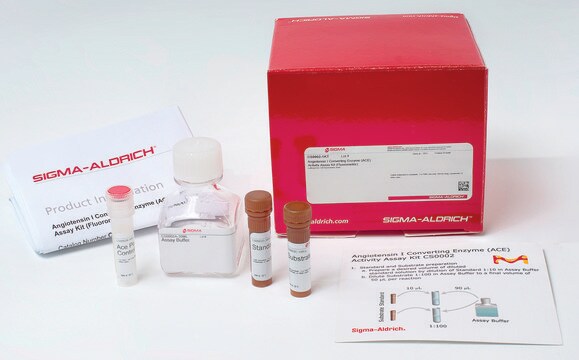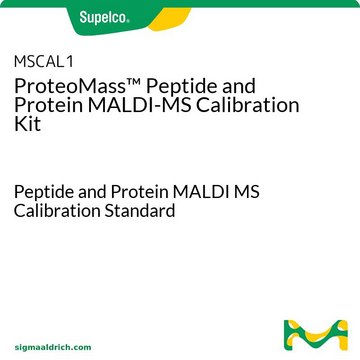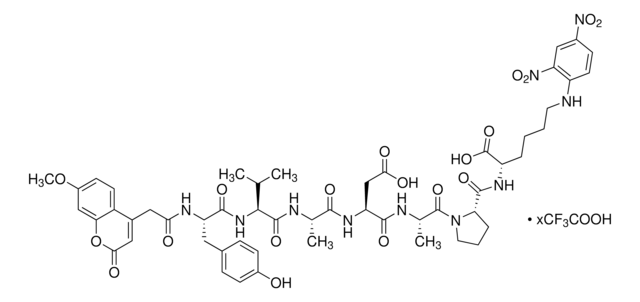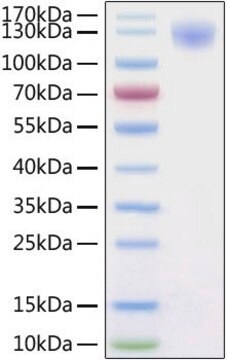おすすめの製品
由来生物
human
品質水準
100
200
リコンビナント
expressed in HEK 293 cells
アッセイ
≥95% (SDS-PAGE)
形状
lyophilized powder
比活性
≥1000000 U/mg
分子量
~85.9 kDa by SDS-PAGE
不純物
≤1 EU/μg protein Endotoxin
UniProtアクセッション番号
輸送温度
ambient
保管温度
−20°C
遺伝子情報
human ... ACE2(59272)
詳細
The gene for angiotensin converting enzyme-2 (ACE-2) is mapped to human chromosome Xp22.2. This protein is the first known human homologue of ACE. ACE2 has been identified from 5′ sequencing of a human heart failure ventricle cDNA library. It contains a signal peptide, one metalloprotease active site and a transmembrane domain. ACE-2 is a secreted and an integral membrane protein. It is expressed predominantly on the endothelium.
アプリケーション
Angiotensin Converting Enzyme-2 (ACE2) has been used in the ACE-2 inhibition assays for inhibitor selectivity studies. It has also been used for identifying potent ACE2-blocking monoclonal antibodies in an on-chip assay and in human-ACE2-blocking assay using a biolayer interferometry biosensor. This approach serves for rational vaccine designing and for the selection of robust immunotherapeutic agents against the severe acute respiratory syndrome coronavirus 2 (SARS-CoV-2) infection.
生物化学的/生理学的作用
Recombinant human Angiotensin Converting Enzyme-2 (ACE-2) is expressed in human HEK 293 cells as a C-terminally flag and histidine-tagged glycoprotein with a calculated molecular mass of 85.9 kDa (amino acids Gln18-Ser740, with a C-terminal 10-His tag). The DTT-reduced protein migrates as a 90-120 kDa polypeptide on SDS-PAGE due to glycosylation. This protein is manufactured in human cells, with no serum. The human cells expression system allows human-like glycosylation and folding, and often supports higher specific activity of the protein.
The angiotensin converting enzyme-2 (ACE-2) functions as carboxydipeptidase. The central role of ACE-2, is to counter ACE activity by reducing the bioavailability of angiotensin (Ang)-II and increasing the Ang(1-7) formation. ACE-2 is a part of the renin-angiotensin system (RAS). Many researches show that Ace-2 ensures the protection of peripheral tissues and might be efficient to treat RAS-related diseases. Also, an imbalance in Ace-2/Ang-(1-7) and ACE/Ang-II axes is important for the onset of cardiovascular diseases. Severe acute respiratory syndrome (SARS) and human coronavirus (HCoV)-NL63 infection viruses has been shown to use its surface protein spike (glycoprotein) to bind to human ACE-2 receptor. The S protein is cleaved into subunits, S1 and S2 during the COVID-19 infection. S1 contains the receptor binding domain (RBD) which enables coronaviruses to bind to the peptidase domain (PD) of ACE2. Thus, ACE2 has become a high focus research target for COVID-19 infection.
単位の定義
One unit is defined as the amount of enzyme required to cleave 1 picomole of the fluorogenic peptide substrate, Mca-YVADAPK(Dnp)-OH in one minute, in 37 °C, pH 7.5.
物理的形状
Lyophilized from 0.22 μm filtered solution in PBS, pH7.4.
試験成績書(COA)
製品のロット番号・バッチ番号を入力して、試験成績書(COA) を検索できます。ロット番号・バッチ番号は、製品ラベルに「Lot」または「Batch」に続いて記載されています。
この製品を見ている人はこちらもチェック
Potently neutralizing and protective human antibodies against SARS-CoV-2
Zost SJ, et al.
Nature, 1-7 (2020)
Huijing Xia et al.
Current hypertension reports, 12(3), 170-175 (2010-04-29)
Angiotensin-converting enzyme 2 (ACE2) is a new component of the renin-angiotensin system (RAS). Accumulating evidence shows that ACE2 provides protective effects in peripheral tissues and has great potential for the treatment of RAS-related diseases. The role of ACE2 in the
Yao-Ling Wang et al.
Journal of medicinal chemistry, 62(15), 7160-7184 (2019-07-04)
The emergence and spread of bacterial pathogens acquired metallo-β-lactamase (MBL) and serine-β-lactamase (SBL) medicated β-lactam resistance gives rise to an urgent need for the development of new dual-action MBL/SBL inhibitors. Application of a pharmacophore fusion strategy led to the identification
Fang Li
Journal of virology, 89(4), 1954-1964 (2014-11-28)
Receptor recognition by viruses is the first and essential step of viral infections of host cells. It is an important determinant of viral host range and cross-species infection and a primary target for antiviral intervention. Coronaviruses recognize a variety of
Rapid isolation and profiling of a diverse panel of human monoclonal antibodies targeting the SARS-CoV-2 spike protein
<BIG>Zost SJ, et al. </BIG>
Nature Medicine (2020)
ライフサイエンス、有機合成、材料科学、クロマトグラフィー、分析など、あらゆる分野の研究に経験のあるメンバーがおります。.
製品に関するお問い合わせはこちら(テクニカルサービス)











